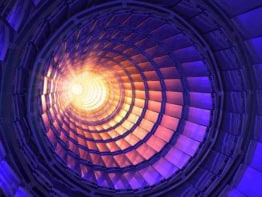
A new way of measuring how the Higgs boson couples to other fundamental particles has been proposed by physicists in France, Israel and the US. Their technique would involve comparing the spectra of several different isotopes of the same atom to see how the Higgs force between the atom’s electrons and its nucleus affects the atomic energy levels.
The effect of the Higgs force is tiny, but the researchers say the test would involve technologies that already exist and that some of the required measurements have already been made. The measurement would provide important information about how the Higgs couples to electrons and quarks, and would complement data gleaned from collisions using the Large Hadron Collider (LHC) at CERN.
Important mysteries
After discovering the Higgs boson at the LHC in 2012, particle physicists now want to understand how it couples to matter such as electrons and quarks. Any deviations in these couplings from the Standard Model of particle physics could reveal whether the Higgs mechanism is responsible for the masses of charged fermions, including the electron. A new way of measuring these deviations has been proposed by Cédric Delaunay of the CNRS, France, Roee Ozeri and Gilad Perez of the Weizmann Institute of Science in Israel and Yotam Soreq of the Massachusetts Institute of Technology in the US.
According to the Standard Model, the Higgs coupling creates an attractive force between the electron and the nucleus. This force decays rapidly with distance from the nucleus, which means it will have a much greater effect on electrons in S orbitals (which overlap the nucleus) than on electrons in P, D or F orbitals (which do not). The energies of photons emitted when an electron moves from a P, D or F orbital to an S orbital would therefore be greater than if the Higgs force were not present.
One way of looking for this difference would be to use different isotopes of the same nucleus. As the isotopes would have different numbers of neutrons, the Higgs force should be greater for those isotopes with more neutrons. That would lead to a difference in energy between the same atomic transition in different isotopes – the Higgs shift.
Linear thinking
The problem is that there are other isotopic differences in atomic spectra that are much larger than those related to the Higgs force. The mass shift (MS) is related to the effect of the different masses of isotopic nuclei and the field shift (FS) to the different charge distributions found in different isotopes. While the MS and FS are fiendishly hard to calculate, there is a well-known linear relationship that links the FS and MS parameters to the observed shifts.
The team’s idea is to measure the shifts of two different transitions in four isotopes of the same atom and display the data on a “King plot”. If there is no Higgs coupling, the data will be represented by a straight line. But if there is a Higgs coupling – and it is described by the Standard Model – there will be a tiny deviation from a straight line. It is likely that this deviation will be too small to measure, but if the Higgs coupling is much larger than predicted by the Standard Model, the researchers say it should be measureable using state-of-the-art atomic spectroscopy.
Delaunay and Soreq told physicsworld.com that such a measurement could provide important information to particle physicists who are trying to understand how the Higgs couples to quarks and electrons – something that will be difficult to extract from LHC collision data. “The method we propose is an example – the first one as far as we know – of how table-top experiments may give us complementary information,” they explain. “This is important to better understand the origin of the mass of the building blocks of matter – is it the Higgs mechanism, or other, unknown sources?”
“Intriguing new application”
“Qualitatively, their arguments make sense,” says Andrei Derevianko of the University of Nevada, Reno. “However, detailed atomic-structure analysis is needed – and they are clearly aware of this need – to make sure that the effect is indeed as large as they claim.”
Marianna Safronova of the University of Delaware also thinks that the proposal could be viable, but points out that a successful experiment would have to accurately separate the effects of the weak interaction. She also agrees with the team’s conclusion that ytterbium isotopes would be a good place to look for the effect, buts adds that calcium may be another viable candidate. Dmitry Budker, an experimental physicist at the University of California, Berkeley, told physicsworld.com that he plans to collaborate with the team to try to make the measurements. “It is not yet clear what specific atomic system – which atoms and/or ions – will be best for this, and so it is also not clear where the experiments will be done. I see an exciting possibility of potentially doing these tests in a range of systems and at different laboratories and facilities.”
The proposal is described in a preprint on arXiv.



